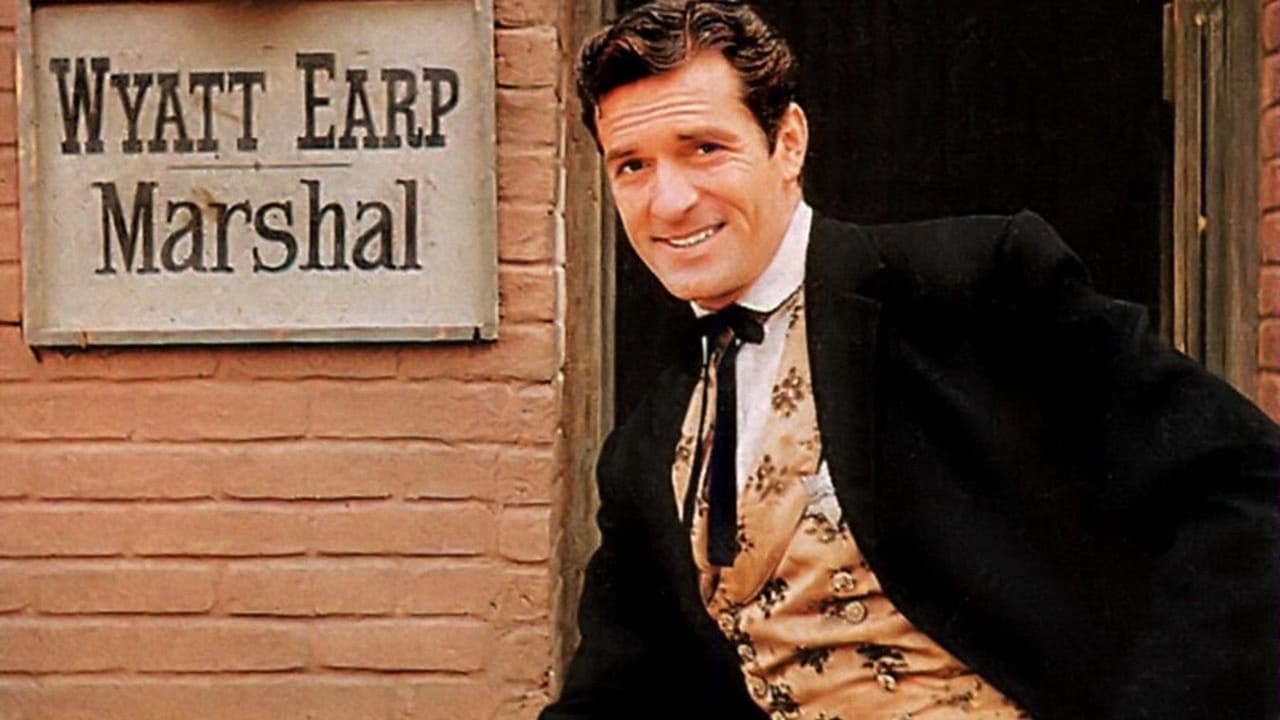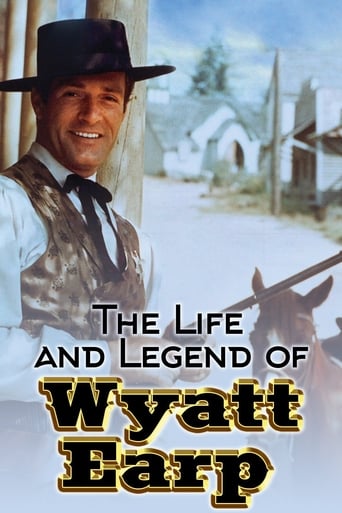

This has turned out to be my longest review in the making, as I began watching "The Life and Legend of Wyatt Earp" episode by episode once it began with the first story on the Encore Western Channel, estimating that to be back in June of 2016 or so. My viewing was made poignant around the third season I think, with Hugh O'Brian's passing on September 5th, 2016. Interestingly, if you catch a Western in which O'Brian appeared before this series began, it's often as a villain. Perhaps that's why, when you catch the traditional opening of each show, O'Brian is shown stepping out of the Marshal's office with that sly, 'cat that ate the canary' grin on his face, that seems to be saying, 'What am I doing here with a gig like this'? In alternate opening scenes in later seasons, O'Brian makes use of the same expression to varying degrees, so maybe it was just his way of being thankful for the role.Stories in the series seem to be loosely based on Wyatt Earp's career as a lawman and his affiliation with characters of the Old West like Doc Holliday, the Clanton Gang, and members of his own family, like brothers Virgil and Morgan Earp. Many of the stories in the series were inspired by the real life Wyatt Earp biographer Stuart Lake, whose reputation for accuracy is more likely to be described as fictional. In fact, Hugh O'Brian has a line in Episode #1.29 - 'The Pinkertons', which seems to address this when he says - "Most of that stuff's (referring to history) just written from hearsay by men that are too lazy to dig up the facts". I thought that was pretty interesting.Generally though, the series does an admirable job in tracing Wyatt Earp's career as a Deputy U.S. Marshal, with Season One following him from Ellsworth, Kansas, on to Wichita (5th episode), and then to Dodge City for the start of the Second Season. With O'Brian's matinée idol good looks and fine physique, it was only a matter of time before the show's producers would write him into a beefcake scene. That happened with Episode #2.39 - 'Wyatt's Love Affair'. Don't let the title of the story fool you though, O'Brian's shirt gets torn off during a fight scene against the foreman of a cattle outfit.With all these early TV Westerns, I'm always on the lookout for celebrity names that eventually went on to bigger and better things. There weren't a lot of big names to appear in this series, some of the familiar character actors of the era who appeared in the show included Bob Steele, Gordon Jones, Harry Lauter, Glenn Strange and Richard Devon. However a few noteworthy future stars who made it into the stories included Angie Dickinson, James Coburn and Louise Fletcher.One thing that happened regularly throughout the course of the series run was the use of the same actor for different roles in different seasons. An example would be Douglas Fowley and Myron Healey, both of whom portrayed Doc Holliday at different times. I particularly liked Fowley's version as an irascible gunman who continuously goaded Wyatt to be more forceful by killing more outlaws. Instead, Marshal Earp probably whacked as many bad guys over the head as Chuck Connors shot and killed in his own series, "The Rifleman".With two hundred and twenty seven episodes, it would be hard to pick a favorite, but one of the more memorable ones, even if entirely made up, was one that brought a host of legendary gunmen to Wyatt's aid in a gunfight. In Episode #2.72 - 'The Time For All Good Men', Wyatt is joined by gunmen Ben Thompson, Mannen Clements, John Wesley Hardin, and Clay Allison, along with Doc Holliday and Bat Masterson, against a gang of outlaws intent on killing Earp. Not much credibility to the story, but it was cool to have all those names in one place at one time.The final season of the show introduced the OK Corral in the first episode, and the stories built up to the famous showdown between the Earps and Doc Holliday against the Clantons and McLaurys on October 28th, 1881. The final four episodes take an interesting approach. Instead of portraying the Gunfight at the OK Corral entirely from start to finish, it's shown in a series of flashbacks based on Wyatt Earp's court testimony after the gunfight. What I found amazing was how accurately the event was portrayed from the standpoint of known, recorded history. The real deal lasted only about thirty seconds with around thirty shots fired between the two factions. Trying to keep track, I came up with counts of 35, 36 and 39 through various replays, so if you're of a mind to do so, you might give it a try yourself if the opportunity ever presents itself.
... View MoreI love the old western programs from the 50's and 60's. This show would have been much better if it didn't have all that humming in the background.I have watched every episode of The Rifleman and enjoy these shows every day on Me TV. The movies on Wyatt Earp starring Kevin Costner and Kurt Russell were both fantastic. I watch them every time they are shown on TV. I think the Life and Legend of Wyatt Earp could have been done better by having an older actor play Bat Masterson rather than portray him as a young inexperienced man. Besides all that I still watch the show and enjoy it as I do all westerns.
... View MoreThe 226 half-hour episodes of the western series "The Life and Legend of Wyatt Earp" were originally broadcast on ABC from 1955-1961. This DVD set contains a selection of 26 episodes from throughout the run of the series. Thus the secondary title "From Ellsworth to Tombstone". The series is somewhat obscure relative to that era's lineup of adult westerns although it was the most realistic of the group and even managed a surprising degree of historical accuracy. It is loosely based on the career of the real-life Wyatt Earp (played by Hugh O'Brian) and sequentially follows the assorted career moves and location changes of this lawman/saloonkeeper. The series starts with Wyatt becoming the marshal of Ellsworth, Kansas. A few episodes later he moves to Dodge City (shades of "Gunsmoke's" Marshall Dillon). The last two seasons take place in Tombstone, Arizona and feature the famous shootout at the O.K. Corral (which is included in this DVD set). O'Brian's acting in the series is a vast improvement over his performance in "Rocketship X- M" a few years earlier. He plays Earp as a strong and rugged character but with a nice touch of humanness and wry charm. Many sidekicks come and go over the course of the series but none rise to the level of a Chester or Festus from "Gunsmoke" or even a Pat Brady from "Roy Rogers". Two actors play Doc Holliday (Douglas Fowley and Myron Healey) and Mason Alan Dinehart plays Bat Masterson. Interviews with O'Brien and Dinehart are included on one of the DVD's. Because the episodes were only a half-hour and because no cast member other than O'Brian really caught on the reputation of the series has suffered in comparison to other examples of the genre. But it features some quality western action without the fluff and philosophy of the longer shows. And it is fair to say that it had considerable influence on development of the adult western series. Then again, what do I know? I'm only a child.I'll tell you a story a real true life story. A tale of the Western frontier. The West, it was lawless, but one man was flawless, And his is the story you'll hear.Wyatt Earp, Wyatt Earp, brave courageous and bold. Long live his fame and long life his glory, and long may his story be told.Well he cleaned up the country, the old wild west country. He made law and order prevail. and none can deny it The legend of Wyatt forever will live on the trail.Wyatt Earp, Wyatt Earp, brave courageous and bold. Long live his fame and long life his glory and long may his story be told.
... View MoreThis tremendously popular and long-running half-hour series featured changes of locale, added characters and deaths, and in several cases changes of the actors plying parts. Central to the proceedings from first to last from 1955--1961 was lean and athletic Hugh O/Brian as a plausible young Wyatt Earp. Into this the life of this fictionalized American icon, other characters real and imagined were introduced. The series was first located in Kansas cattle towns such as Wichita and Dodge City; then O'Brian moved to Tombstone, Arizona. He became and remained a town marshal during this time. Other regulars of note in this very intelligently-made, innovative and realistic series--one whose 'history' was decidedly not of a documentary variety--included Lloyd Corrigan as Ned Buntline, Alan Dinehart as Bat Masterson, several Doc Hollidays, Gloria Talbott, Don Haggerty, Denver Pyle, Damian O'Flynn, Carol Stone as Kate Holliday, Selmer Jackson, Randy Stuart, Wlliam Tannen, Paul Brinegar as Mayor "Dog" Kelly, Trevor Bardette as Old Man Clanton, Steve Brodie as Sheriff Johnnie Behan, Ross Elliott and others as Wyatt Earp's brothers, etc. The peculiar and memorable structure of the show allowed "changes" in character, relationships, locations, etc. when many series did not permit such alterations. In addition, the show's producers used some actors in guest roles many times, including Sam Flint, Steve Pendleton, Rico Alaniz and more. Guest stars of note included Anna May Wong, Arthur Space, Ann Robinson, Howard Petrie, George Wallace, Richard Travis, Robert Lowery, James Coburn, Peggy Knudsen, Fay Baker, Carolyn Craig, Jim Bannon, Nancy Hadley, Whitner Bissell, Angie Dickinson, Francis de Sales, Peter Mamakos, Ed Nelson, Richard Devon, Lane Bradford, Dorothy Green and John Vivyan, plus many more. Directors of record included Paul Landres and Frank McDonald. The staff of writers included Frederick Hazlitt Brennan, John Dunkel and Dan Ullman. These professionals kept up the show's very consistent quality throughout, I suggest. During its run, this series was shot by six cinematographers but only two art directors, by Ralph Berger and Albert M. Pyke, created its authentic western 'look'. Set decorations were done by Jack Mills and Kenneth W. Swartz. Bruce Bilson was second-unit director, with Hollywood veteran Roy Rowland as executive producer. The producers employed a gun expert, several production specialists and very good but less-expensive talents in order to keep up their high-standard of quality. The series ended with a memorable five-part but not-very-accurate gunfight at the OK Corral. This by my lights was a first-rate narrative TV series, I assert, one which was much imitated for decades afterward. Also of note was the show's theme song, whose picture of Earp set the tone for Eliot Ness, The Lawman, and Kojack among many other TV lawmen to come.
... View More